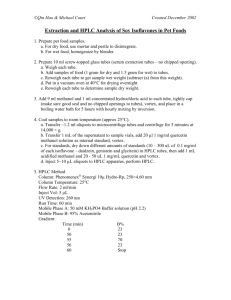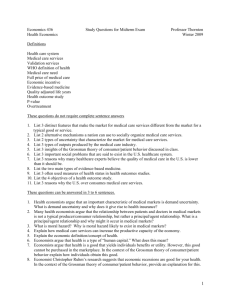Quercetin induces growth arrest through activation of FOXO1
advertisement
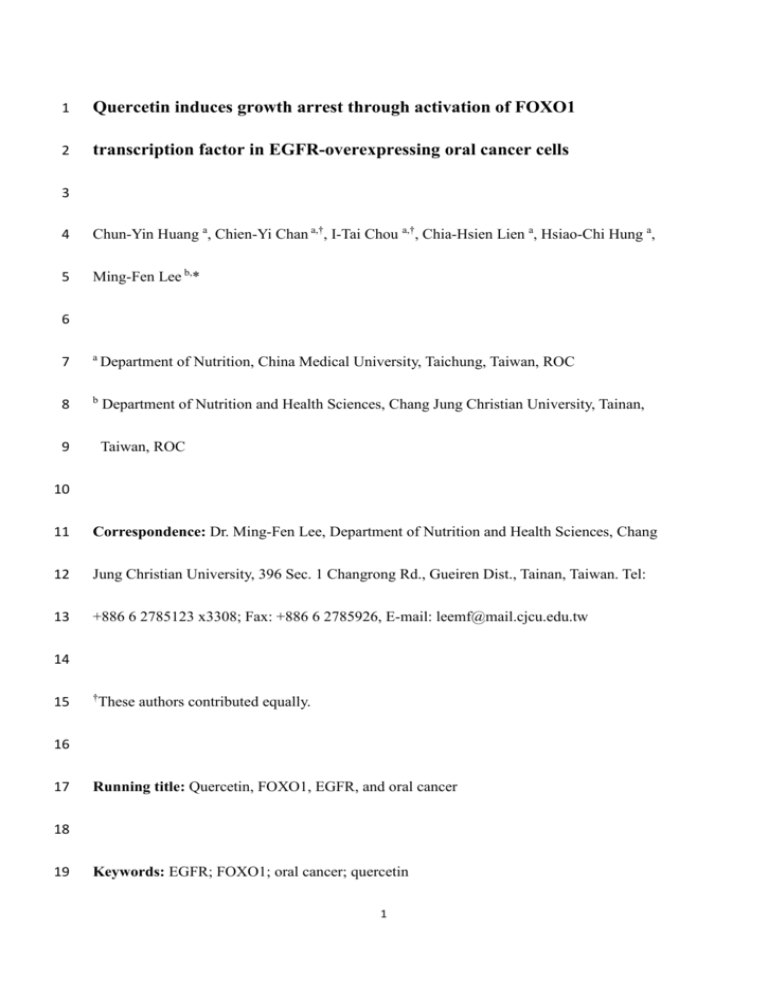
1 Quercetin induces growth arrest through activation of FOXO1 2 transcription factor in EGFR-overexpressing oral cancer cells 3 4 Chun-Yin Huang a, Chien-Yi Chan a,†, I-Tai Chou a,†, Chia-Hsien Lien a, Hsiao-Chi Hung a, 5 Ming-Fen Lee b,* 6 7 a Department of Nutrition, China Medical University, Taichung, Taiwan, ROC 8 b Department of Nutrition and Health Sciences, Chang Jung Christian University, Tainan, 9 Taiwan, ROC 10 11 Correspondence: Dr. Ming-Fen Lee, Department of Nutrition and Health Sciences, Chang 12 Jung Christian University, 396 Sec. 1 Changrong Rd., Gueiren Dist., Tainan, Taiwan. Tel: 13 +886 6 2785123 x3308; Fax: +886 6 2785926, E-mail: leemf@mail.cjcu.edu.tw 14 15 † These authors contributed equally. 16 17 Running title: Quercetin, FOXO1, EGFR, and oral cancer 18 19 Keywords: EGFR; FOXO1; oral cancer; quercetin 1 20 21 Funding sources: This work was supported by the grants, CMU97-303 (China Medical 22 University) and NSC98-2320-B-039-021-MY3 (National Science Council) to Chun-Yin 23 Huang, and NSC98-2320-B-309-002-MY3 and NSC101-2320-B-309-001 (National Science 24 Council) to Ming-Fen Lee. 25 2 26 Abstract 27 28 The squamous cell carcinomas of the head and neck (SCCHN) with aberrant epidermal 29 growth factor receptor (EGFR) signaling are often associated with poor prognosis and low 30 survival. Therefore, efficient inhibition of the EGFR signaling could intervene with the 31 development of malignancy. Quercetin appears anti-tumorigenesis, but the underlying 32 mechanism remains unclear in oral cancer. Fork-head box O (FOXO) transcription factors, 33 Akt downstream effectors, are important regulators of cell growth. Here, we hypothesized 34 that FOXO1 might be crucial in quercetin-induced growth inhibition in 35 EGFR-overexpressing oral cancer. Quercetin treatment suppressed cell growth by inducing 36 G2 arrest and apoptosis in EGFR-overexpressing HSC-3 and TW206 oral cancer cells. 37 Quercetin inhibited EGFR/Akt activation with a concomitant induction of FOXO1 activation. 38 FOXO1-knockdown attenuated quercetin-induced p21 and FasL expression and subsequent 39 G2 arrest and apoptosis, respectively. Likewise, quercetin suppressed tumor growth in HSC-3 40 xenograft mice. Taken together, our data indicate that quercetin is an effective anti-cancer 41 agent and that FOXO1 is crucial in quercetin-induced growth suppression in 42 EGFR-overexpressing oral cancer. 43 44 3 45 1. Introduction 46 47 The invasive squamous cell carcinomas of the head and neck (SCCHN) frequently 48 overexpress epidermal growth factor receptor (EGFR) [1], leading to unfavorable clinical 49 outcome–high recurrence and low survival rates [2, 3]. Aberrant EGFR/PI3K/Akt signaling 50 pathway is often responsible for the malignant phenotype [4]. Although several 51 EGFR-targeting drugs are clinically available [5-7], their wide application is limited by the 52 resistance to the drugs and mutations in the EGFR downstream effectors in some patients [8]. 53 Therefore, to improve therapeutic efficacy, new anti-cancer agent should be considered 54 accordingly. 55 56 Quercetin (3,3’,4’,5,7-pentahydroxyflavone) is one of the major dietary flavonoids 57 found in a wide range of fruits, vegetables, and beverages [9]. Among those, onion, apple, 58 and red wine are good sources of quercetin. The antioxidant, anti-inflammatory, as well as 59 anti-proliferative and apoptosis aspects of quercetin have been widely investigated [9]. A 60 phase I clinical trial indicated that quercetin can be safely administered and its plasma levels 61 are sufficient to inhibit lymphocyte tyrosine kinase activity [10]. Consumption of quercetin 62 from onions and apples was inversely associated with lung cancer risk, supporting the 63 chemopreventive effect of quercetin [11]. The chemotherapeutic efficacy of quercetin has 4 64 also been demonstrated in many types of cancer [12-18]. Quercetin exerts its anti-cancer 65 property mainly through induction of growth arrest in G1 or G2 [14, 15, 17, 19], apoptosis 66 [15, 16, 20], and inhibition of angiogenesis [13] as evidenced by down-regulating the 67 expression of oncogenes (HER2 [21], H-ras, K-ras, c-myc [22], or COX-2 [13] ) and mutant 68 p53 [23], or up-regulating cell cycle control proteins (p21WAF1 and p27KIP1) [18, 19, 24]. 69 In addition, quercetin inhibits several tyrosine and serine–threonine kinases, whose activities 70 are linked to cell surface receptors-transduced survival pathways (PI3K/Akt/PKB) [25-27]. 71 Nonetheless, the effect of quercetin on oral cancers remains uncertain. Quercetin seems to 72 induce apoptosis in some human oral cancer cell lines [28-30]; however, the underlying 73 mechanisms are still elusive. 74 75 Fork-head box O (FOXO) transcription factors share a conserved “fork-head box” 76 DNA-binding domain, which comprise four members in mammals: FOXO1, FOXO3a, 77 FOXO4, and FOXO6 [31, 32]. FOXO factors are involved in a wide range of biological 78 processes, including cell cycle arrest, apoptosis, DNA repair, glucose metabolism, oxidative 79 stress resistance, and longevity [32]. The biological activity of FOXO factors is highly 80 dependent on their intracellular trafficking, mediated by post-translational modifications in 81 phosphorylation, acetylation, or ubiquitination [33]. In addition, FOXO factors share highly 82 conserved sites within and nearby their DNA binding domains for phosphorylation by the 5 83 survival PI3K/Akt signaling pathway. The growth factors-mediated Akt phosphorylation on 84 these conserved residues negatively regulates FOXO expression and activity [34]. In this 85 regard, FOXO factors are implicated in pathogenesis including aging, diabetes, immune 86 disease, infertility, neurodegeneration, and cancer [35]. Among FOXO factors, Increased 87 p-FOXO1 or decreased FOXO1 expression is often associated with tumorigenesis [36]. 88 FOXO1 may exert its tumor suppression function through its transcription-dependent 89 expression on growth arrest and apoptosis-related genes, including p15, p19, NOXA, FasL, 90 TRAIL, and Bim [37-39]. The promoters of these genes comprise the consensus sequence 91 T/C-G/A-A-A-A-C-A-A recognized by FOXO1 [35]. Alternatively, FOXO1 can mediate 92 cancer cell death through induction of autophagy which is independent of its transcriptional 93 activity [40]. Similarly, FOXO1 inhibits Runx2-mediated cell migration and invasion 94 independent of its transcriptional activity [41]. Together, FOXO1 appears to be a potential 95 therapeutic target of anti-cancer reagents [42-46]. 96 97 Aberrant EGFR expression and PI3K mutation are often observed in invasive SCCHN; 98 however, the role of transcription factor FOXO1 as a downstream target of activated 99 EGFR/PI3K/Akt signaling axis in oral cancer still remains unclear. Therefore, in the present 100 study, we aimed to investigate the anti-cancer efficacy of quercetin in human oral cancer cell 101 lines with elevated EGFR expression, and to further identify the crucial role of FOXO1 factor 6 102 in quercetin-mediated growth suppression. 7 103 2. Materials and methods 104 105 2.1 Reagents, antibodies, and plasmids 106 107 All chemicals including quercetin were purchased from Sigma (St. Louis, MO) and 108 antibodies were purchased from Cell Signaling Technology (Beverly, MA), respectively, 109 unless specified otherwise. PVDF membrane and ECL detection reagents were from Perkin 110 Elmer Life Sciences, Inc. The annexin V-FITC apoptosis detection kit was purchased from 111 BD Biosciences (San Jose, CA). Antibody against cyclin D1 was purchased from Santa Cruz 112 Biotechnology (Santa Cruz, CA) and anti-α-tubulin antibody was purchased from Abcam 113 (Cambridge, MA). FOXO1-specific siRNA and the Lipofectamine RNAiMAX reagent were 114 purchased from Invitrogen (Grand Island, NY). The pGL3-FHRE-luc plasmid was obtained 115 from Addgene (Cambridge, USA; Addgene database plasmid 1789) and the PolyJet In Vitro 116 DNA Transfection Reagent was purchased from SignaGen Laboratories (Ijamsville, MD). 117 The NE-PER Nuclear and Cytoplasmic Extraction Reagents were purchased from Thermo 118 Fisher Scientific (Rockford, IL). 119 120 2.2 Cell culture and treatment 121 8 122 HSC-3 and TW206 human oral squamous carcinoma and HGF human gingival fibroblasts 123 cells were kind gifts of Dr. Hsin-Ling Yang at China Medical University (Taichung, Taiwan). 124 HSC-3 and HGF cells were maintained in DMEM-F12 and DMEM (Invitrogen), respectively, 125 supplemented with 10% fetal bovine serum (FBS) and 1% antibiotic-antibimycotic (Gibco). 126 All cells were cultured with 5% CO2 at 37°C. 127 128 2.3 Cell viability assay 129 130 Cell viability was measured by trypan blue method. Cells were allowed to grow in 6-well 131 culture plates and then treated with various concentrations of quercetin (0-50 μM) for 132 indicated hours. Then, cells were trypsinized and viable cells were stained with trypan blue 133 for hemocytometric counting. 134 135 2.4 Western blotting 136 137 Cells were washed with cold PBS and lysed in RIPA buffer containing 150 mM NaCl, 10 138 mM Tris (pH 7.2), 0.1% SDS, 1% Triton X-100, 1% deoxycholate, 5 mM EDTA, and 139 protease/phosphatase inhibitors. Protein concentration was determined by BCA protein assay, 140 and denatured proteins were separated in 8% to 15% SDS-PAGE, and transferred onto PVDF 9 141 membranes. Nonspecific binding was blocked with 5% milk in TBST buffer (20 mM Tris 142 base, 140 mM NaCl, pH 7.6, 0.1% Tween-20) for 1 h, followed by incubation with primary 143 antibodies at 4°C overnight and secondary antibodies at room temperature for 1 h. Blots were 144 visualized by ECL detection reagents. 145 146 2.5 Cell cycle analysis 147 148 HSC-3 and TW206 cells were seeded onto 6-well plates and serum-starved for 18 h followed 149 by quercetin treatment in growth media for 24 h. Cells were then trypsinized, washed with 150 PBS, and fixed in cold 70% ethanol at -20 °C. The fixed cells were collected and stained in a 151 solution containing 0.5 ml of 4 μg/ml of PI, 0.5 mg/ml of RNase, and 1% Triton X-100 for 30 152 min at 4 °C. DNA content of these cells was analyzed using a FACScan flow cytometer 153 (Becton Dickinson). 154 155 2.6 Colony formation assay 156 157 After incubation with the indicated concentration of quercetin, cells were washed with PBS, 158 fixed with 10% formalin (Mallinckrodt Chemicals) for 10 min, and stained with 0.05% 159 crystal violet (Panreac Quimica S.A.U.) for 30 min. Dishes were subjected to colony 10 160 counting and optical density measurement at 540 nm. 161 162 2.7 Apoptosis analysis 163 164 Cells were seeded onto 6-well plates in growth media and treated with quercetin for 24 h. 165 Cells were then trypsinized, washed with PBS, and resuspended in binding buffer (10 mM 166 Hepes/NaOH, pH 7.4, 140 mM NaCl, and 2.5 mM CaCl2) at a concentration of 1×106 167 cells/ml. One hundred microliters of the lysis solution were transferred to a polystyrene tube, 168 followed by 5 μl of annexin V-FITC and 5 μl of PI. The mixtures were sheltered from light 169 and incubated for 15 min at room temperature. Finally, 400 μl of 1× binding buffer was 170 added to each tube and cells were analyzed using a FACScan flow cytometer (Becton 171 Dickinson). 172 173 2.8 Reporter assay 174 175 The pGL3-FHRE-luc and β-galactosidase plasmids with or without FOXO1 siRNA were 176 co-transfected into HSC-3 cells for 24 h, followed by another 24 h of quercetin treatment. 177 Cell lysates were collected in lysis solution (Applied Biosystems, Carlsbad, CA) according to 178 the manufacturer’s protocol. The Dual Light® System (Applied Biosystems) was used to 11 179 quantify luciferase and β-galactosidase activities. 180 181 2.9 Xenograft mice 182 183 Seven-week-old male nude mice were purchased from National Laboratory Animal Center 184 (Taipei, Taiwan). The animal study protocol, IACUC 98-71-N, was reviewed and approved 185 by the Institutional Animal Care and Use Committee (IACUC) of the China Medical 186 University. The animals were given free access to autoclaved food and water during the study. 187 After 2-week of acclimation, animals were implanted subcutaneously with HSC-3 cells (3 X 188 106) suspended with liquid Matrigel to a final volume of 100 μl into the flank regions and 189 randomly assigned into the control or quercetin group. Tumor size was recorded every other 190 day for 40 days. Two weeks after the implantation, quercetin (3 mg/kg/day) or PBS was 191 given via gavage feeding. Tumor volume = ½(length × width2). 192 193 2.10 Statistical analysis 194 195 Data are expressed as mean ± SD from at least three independent experiments. Statistical 196 significance was analyzed using Student’s t test or Duncan’s multiple range tests. Results 197 were considered significantly different at p < 0.05. 12 198 3 Results 199 200 3.1 Quercetin inhibits cell growth in human oral cancer cells 201 202 The growth-inhibitory effect of quercetin has been shown in various types of cancer; however, 203 its efficacy on oral squamous cancer cells remains elusive. To examine the effect of quercetin 204 on oral cancer, we exposed two human tongue squamous carcinoma cell lines, HSC-3 and 205 TW206 [47], and a control, human gingival fibroblast HGF cells, to various concentrations of 206 quercetin. Quercetin potently inhibited HSC-3 cell growth as compared with TW206 and 207 HGF cells (Fig. 1A). The IC50 of quercetin in HSC-3 cells was around 20 μM, much less 208 than that of TW206 (45 μM). These results indicate that the metastatic HSC-3 cell line is 209 more susceptible to quercetin than the other two cell lines tested. Indeed, quercetin 210 supplementation for 7 days significantly suppressed HSC-3 colony formation in a 211 dose-dependent manner with an IC50 of 7 μM (Fig. 1B). These data support quercetin as a 212 potential anti-cancer reagent in oral squamous carcinomas. 213 214 Cell cycle arrest and apoptosis are two main factors responsible for growth suppression. 215 Quercetin has been shown to cause growth arrest in various cancer cells [14, 15, 17, 19]. To 216 investigate the effect of quercetin on cell proliferation in oral cancer, we performed flow 13 217 cytometric analysis for cell cycle distribution upon quercetin addition. In both HSC-3 and 218 TW206 cells, quercetin (20 μM) treatment for 24 h resulted in a significant increase of cell 219 numbers in G2/M phase (Fig. 2A), with concomitant reductions of G2/M phase cyclins, 220 cyclin A and B1 [48], whereas quercetin showed no suppressive effect on G1 phase cyclin, 221 cyclin D1 (Fig. 2B). In addition, quercetin induced the expression of p21 but not negative G1 222 regulator, p15 [49] (Fig. 2B). These results demonstrate that quercetin is a potent inducer of 223 growth arrest in human oral squamous carcinoma cells. 224 225 Next, we evaluated the apoptotic efficacy of quercetin in oral cancer cells. Upon 226 quercetin treatment (0-30 μM), both HSC-3 and TW206 cells displayed an accumulation of 227 apoptotic cells in a dose-dependent manner (Fig. 2C). The apoptosis-inducing effect was 228 further confirmed by the observations of the condensed chromatin staining (Fig. 2D) and the 229 increased FasL and cleaved caspase 3 (Fig. 2E) upon quercetin treatment in HSC-3 cells. 230 However, quercetin had little effect on the expression of Bax, a pro-apoptotic member of the 231 Bcl-2 family (Fig. 2E). These results suggest the potential involvement of FasL-mediated 232 extrinsic apoptotic pathway in quercetin-mediated cell death of HSC-3. Taken together, both 233 growth arrest and apoptosis are responsible for the anti-cancer effect of quercetin in oral 234 squamous carcinoma cells. 235 14 236 3.2 Quercetin modulates the EGFR/Akt signaling axis 237 238 Aberrant EGFR activation is the key cause of oral cancer malignancy. Therefore, we studied 239 the effect of quercetin on EGFR signaling. In EGFR-overexpressing HSC-3 cells (Fig. 3A), 240 the protein levels of p-Y1086-EGFR and its downstream effector, p-Akt, were decreased 241 upon quercetin treatment in both time- (Fig. 3B) and dose-(Fig. 3C) dependent patterns, 242 whereas the p-Y1045-EGFR levels were gradually increased (Fig. 3B). It is noteworthy that 243 the phosphorylation at tyrosine 1045 is responsible for c-Cbl-mediated ubiquitination and 244 degradation of EGFR protein [50]. These results suggest quercetin as an important modulator 245 of the EGFR/Akt pathway. 246 247 3.3 Quercetin regulates FOXO1 activation 248 249 FOXO transcription factors play a role in the regulation of cell growth and apoptosis. The 250 activity of FOXO factors can be regulated by Akt-mediated nucleus exclusion and subsequent 251 degradation [51]. Therefore, we examined the effect of quercetin on FOXOs. While HSC-3 252 cells displayed increased FOXO1 protein levels in both dose- and time-dependent manners 253 (Fig. 4A-B) upon quercetin treatment, no change of FOXO3a expression was observed (Fig. 254 4B). In addition, quercetin reduced the phosphorylation of cytoplasmic FOXO1 at serine 256 15 255 (Fig. 4C), and induced the translocation of FOXO1 from cytoplasm to nucleus as shown by 256 Western blotting (Fig. 4C) and immunofluorescence (Fig. 4D) in HSC-3 cells. These results 257 suggest that quercetin induces the nuclear translocation of FOXO1 and, thereby, 258 transactivates FOXO1. Indeed, quercetin activated a luciferase reporter gene driven by three 259 fork-head responsive elements (FHREs) in HSC-3 cells, whereas such activation was 260 abolished upon FOXO1 knockdown (Fig. 4E). Since these FHREs were originally identified 261 in FasL promoter [52], our data indicate that quercetin activates FOXO1 and induces FasL 262 expression. Furthermore, as in the treatment of quercetin (Fig. 3A), the administration of 263 LY294002, a PI3K inhibitor, increased FOXO1 expression in a time-dependent manner in 264 HSC-3 cells (Fig. 4F). Taken together, FOXO1 is a downstream transducer of quercetin. 265 266 3.4 Quercetin mediates growth inhibition through FOXO1 activation 267 268 To verify if FOXO1 plays a key role in quercetin-mediated growth inhibition in oral cancer 269 cells, we suppressed FOXO1 expression by FOXO1-specific siRNA in the presence of 270 quercetin. FOXO1 knockdown relieved the suppression effect of quercetin on cell growth 271 (Fig. 5A) and colony formation (Fig. 5B). In particular, FOXO1 suppression abolished 272 quercetin-mediated G2/M arrest in both HSC-3 and TW206 cells (Fig. 5C). FOXO1 273 knockdown reduced quercetin-induced p21 expression (Fig. 5D); ectopic expression of 16 274 FOXO1 resulted in increased p21 expression (Fig. 5E). These results support the role of 275 FOXO1 in quercetin-mediated growth inhibition where the subsequent p21 expression might 276 be responsible for the G2 arrest. 277 278 We next examined the role of FOXO1 in quercetin-mediated apoptosis. FOXO1 279 knockdown alleviated quercetin-induced apoptosis (Fig. 6A) and reduced the expression 280 levels of FasL and cleaved caspase 3 (Fig. 6B) in HSC-3 cells. These results further suggest 281 that quercetin-induced cell death might, in part, through FOXO1-mediated FasL expression. 282 283 3.5 Quercetin inhibits tumor growth with concomitant FOXO1 induction in vivo 284 285 The anti-growth effect of quercetin on HSC-3 cells was further tested with xenograft mice. 286 Both tumor size and weight of HSC-3-engineered xenografts were significantly suppressed 287 upon quercetin administration as compared with the control (Fig. 7A-B). In addition, 288 quercetin-fed xenograft mice also exhibited higher FOXO1 expression than those of control 289 animals (Fig. 7C). Therefore, in consistent with the in vitro results, the in vivo data indicate 290 that quercetin inhibits tumor growth and induces FOXO1 expression. 291 17 292 4 Discussion 293 294 Aberrant activation of the EGFR/PI3K/Akt signaling pathway is often associated with cancer 295 malignancy [53]. Accordingly, this deregulated signaling pathway becomes a conceivable 296 therapeutic target in anti-cancer strategy. HSC-3 cell line, a cervical lymph node metastasis 297 originated from a tongue primary tumor, displays activated EGFR/PI3K/Akt signaling by 298 expressing augmented EGFR levels and a constitutively active PI3K mutant [53]. Quercetin 299 has been reported as a potent PI3K inhibitor [25], and the efficacy of quercetin inhibition on 300 tyrosine kinase may continue for 16 h [10]. In the current study, we observed 301 down-regulation of EGFR and Akt phosphorylation upon quercetin treatment for 12 h in 302 HSC-3 cells. It is possible that quercetin might compete with ATP for the binding to the 303 catalytic site of the PI3K [25]. Our data potentiate quercetin as an alternative regimen for oral 304 cancer patients carrying an aberrant EGFR/PI3K/Akt signaling axis. 305 306 Oral squamous cancer cells with EGFR overexpression appear susceptible to 307 anti-proliferation effect of quercetin. The concentration of quercetin to inhibit SCC-1483 cell 308 viability by half is about 40 μM [29], in contrast with 20 μM for EGFR-overexpressing 309 HSC-3 oral cancer cell line. In the current study, quercetin-induced G2 arrest is associated 310 with the induction of FOXO1-dependent p21 expression in HSC-3 human oral cancer cells. 18 311 Similar induction effect on p21 has also been reported in quercetin-treated breast and prostate 312 cancer cells [17, 18]. However, the concentration of quercetin to induce p21 expression in 313 PC-3 cells was much higher (50-100 μM) than that of HSC-3 cells. 314 315 The involvement of p21 in G2 arrest could result from either DNA damage or mitogen 316 starvation [49]. Seoane et al. proposed that, in response to TGF-β, FOXO1 forms a complex 317 with Smad 3/4, which further induces p21 expression through the binding of the Forkhead 318 binding element within the p21 promoter [54]. The link between FOXO1 and p21 was further 319 supported by the finding that FOXO1-mediated p21 expression is crucial in the antineoplastic 320 effect of calorie restriction [55]. 321 322 Quercetin may exert apoptotic function in a FOXO1-dependent fashion. Here, we 323 demonstrated that quercetin treatment caused apoptosis in both HSC-3 and TW206 cells (Fig. 324 2C). This phenomenon was supported by increased levels of cleaved caspase 3 and FasL 325 upon quercetin addition (Fig. 2E). In particular, FOXO1 suppression alleviated 326 quercetin-mediated cell death and reduced the induction of FasL and cleaved caspase 3 (Fig. 327 6). Mutant p53 could block apoptosis, whereas quercetin can down-regulate mutant p53 328 protein levels [23]. Since HSC-3 carries a truncated p53 mutant [56], this could be an 329 alternative mechanism how quercetin facilitates cell death in HSC-3 cells. 19 330 331 In summary, our data support quercetin as an efficient anti-cancer agent in 332 EGFR-overexpressing oral cancers; the schematic mechanism is illustrated in Fig. 8. By 333 suppressing EGFR/Akt activation, quercetin stimulates FOXO1 activation and subsequently 334 induces p21 and FasL which link to G2 arrest and apoptosis, respectively. The current study 335 provides several lines of evidence both in vivo and in vitro to support quercetin as a potential 336 therapeutic agent for a subset of oral squamous carcinomas. Specifically, the mechanism 337 involving FOXO1 in the anti-cancer action of quercetin may be translated to the future 338 application as clinical stratagem in cure of oral cancer. 339 340 Conflict of interest 341 The authors declare no conflict of interest. 342 20 343 5 References 344 345 [1] Sheu JJ, Hua CH, Wan L, Lin YJ, Lai MT, Tseng HC, et al. Functional genomic analysis 346 identified epidermal growth factor receptor activation as the most common genetic event in 347 oral squamous cell carcinoma. Cancer Res. 2009;69:2568-76. 348 [2] Chung CH, Ely K, McGavran L, Varella-Garcia M, Parker J, Parker N, et al. Increased 349 epidermal growth factor receptor gene copy number is associated with poor prognosis in head 350 and neck squamous cell carcinomas. J Clin Oncol. 2006;24:4170-6. 351 [3] Temam S, Kawaguchi H, El-Naggar AK, Jelinek J, Tang H, Liu DD, et al. Epidermal 352 growth factor receptor copy number alterations correlate with poor clinical outcome in 353 patients with head and neck squamous cancer. J Clin Oncol. 2007;25:2164-70. 354 [4] Modjtahedi H, Essapen S. Epidermal growth factor receptor inhibitors in cancer treatment: 355 advances, challenges and opportunities. Anticancer Drugs. 2009;20:851-5. 356 [5] Burtness B. The role of cetuximab in the treatment of squamous cell cancer of the head 357 and neck. Expert Opin Biol Ther. 2005;5:1085-93. 358 [6] Burtness B, Goldwasser MA, Flood W, Mattar B, Forastiere AA. Phase III randomized 359 trial of cisplatin plus placebo compared with cisplatin plus cetuximab in metastatic/recurrent 360 head and neck cancer: an Eastern Cooperative Oncology Group study. J Clin Oncol. 361 2005;23:8646-54. 21 362 [7] Dobelbower MC, Russo SM, Raisch KP, Seay LL, Clemons LK, Suter S, et al. Epidermal 363 growth factor receptor tyrosine kinase inhibitor, erlotinib, and concurrent 5-fluorouracil, 364 cisplatin and radiotherapy for patients with esophageal cancer: a phase I study. Anticancer 365 Drugs. 2006;17:95-102. 366 [8] Ratushny V, Astsaturov I, Burtness BA, Golemis EA, Silverman JS. Targeting EGFR 367 resistance networks in head and neck cancer. Cell Signal. 2009;21:1255-68. 368 [9] Lamson DW, Brignall MS. Antioxidants and cancer, part 3: quercetin. Altern Med Rev. 369 2000;5:196-208. 370 [10] Ferry DR, Smith A, Malkhandi J, Fyfe DW, deTakats PG, Anderson D, et al. Phase I 371 clinical trial of the flavonoid quercetin: pharmacokinetics and evidence for in vivo tyrosine 372 kinase inhibition. Clin Cancer Res. 1996;2:659-68. 373 [11] Le Marchand L, Murphy SP, Hankin JH, Wilkens LR, Kolonel LN. Intake of flavonoids 374 and lung cancer. J Natl Cancer Inst. 2000;92:154-60. 375 [12] Vargas AJ, Burd R. Hormesis and synergy: pathways and mechanisms of quercetin in 376 cancer prevention and management. Nutr Rev. 2010;68:418-28. 377 [13] Xiao X, Shi D, Liu L, Wang J, Xie X, Kang T, et al. Quercetin suppresses 378 cyclooxygenase-2 expression and angiogenesis through inactivation of P300 signaling. PLoS 379 One. 2011;6:e22934. 380 [14] Vidya Priyadarsini R, Senthil Murugan R, Maitreyi S, Ramalingam K, Karunagaran D, 22 381 Nagini S. The flavonoid quercetin induces cell cycle arrest and mitochondria-mediated 382 apoptosis in human cervical cancer (HeLa) cells through p53 induction and NF-kappaB 383 inhibition. Eur J Pharmacol. 2010;649:84-91. 384 [15] Zhang Q, Zhao XH, Wang ZJ. Cytotoxicity of flavones and flavonols to a human 385 esophageal squamous cell carcinoma cell line (KYSE-510) by induction of G2/M arrest and 386 apoptosis. Toxicol In Vitro. 2009;23:797-807. 387 [16] Rubio S, Quintana J, Eiroa JL, Triana J, Estevez F. Acetyl derivative of quercetin 388 3-methyl ether-induced cell death in human leukemia cells is amplified by the inhibition of 389 ERK. Carcinogenesis. 2007;28:2105-13. 390 [17] Vijayababu MR, Kanagaraj P, Arunkumar A, Ilangovan R, Aruldhas MM, Arunakaran J. 391 Quercetin-induced growth inhibition and cell death in prostatic carcinoma cells (PC-3) are 392 associated with increase in p21 and hypophosphorylated retinoblastoma proteins expression. 393 J Cancer Res Clin Oncol. 2005;131:765-71. 394 [18] Choi JA, Kim JY, Lee JY, Kang CM, Kwon HJ, Yoo YD, et al. Induction of cell cycle 395 arrest and apoptosis in human breast cancer cells by quercetin. Int J Oncol. 2001;19:837-44. 396 [19] Beniston RG, Campo MS. Quercetin elevates p27(Kip1) and arrests both primary and 397 HPV16 E6/E7 transformed human keratinocytes in G1. Oncogene. 2003;22:5504-14. 398 [20] Wang P, Zhang K, Zhang Q, Mei J, Chen CJ, Feng ZZ, et al. Effects of quercetin on the 399 apoptosis of the human gastric carcinoma cells. Toxicol In Vitro. 2012;26:221-8. 23 400 [21] Jeong JH, An JY, Kwon YT, Li LY, Lee YJ. Quercetin-induced ubiquitination and 401 down-regulation of Her-2/neu. J Cell Biochem. 2008;105:585-95. 402 [22] Ranelletti FO, Maggiano N, Serra FG, Ricci R, Larocca LM, Lanza P, et al. Quercetin 403 inhibits p21-RAS expression in human colon cancer cell lines and in primary colorectal 404 tumors. Int J Cancer. 2000;85:438-45. 405 [23] Avila MA, Velasco JA, Cansado J, Notario V. Quercetin mediates the down-regulation of 406 mutant p53 in the human breast cancer cell line MDA-MB468. Cancer Res. 1994;54:2424-8. 407 [24] Casagrande F, Darbon JM. Effects of structurally related flavonoids on cell cycle 408 progression of human melanoma cells: regulation of cyclin-dependent kinases CDK2 and 409 CDK1. Biochem Pharmacol. 2001;61:1205-15. 410 [25] Matter WF, Brown RF, Vlahos CJ. The inhibition of phosphatidylinositol 3-kinase by 411 quercetin and analogs. Biochem Biophys Res Commun. 1992;186:624-31. 412 [26] Gulati N, Laudet B, Zohrabian VM, Murali R, Jhanwar-Uniyal M. The antiproliferative 413 effect of Quercetin in cancer cells is mediated via inhibition of the PI3K-Akt/PKB pathway. 414 Anticancer Res. 2006;26:1177-81. 415 [27] Sun ZJ, Chen G, Hu X, Zhang W, Liu Y, Zhu LX, et al. Activation of 416 PI3K/Akt/IKK-alpha/NF-kappaB signaling pathway is required for the apoptosis-evasion in 417 human salivary adenoid cystic carcinoma: its inhibition by quercetin. Apoptosis. 418 2010;15:850-63. 24 419 [28] Chowdhury SA, Kishino K, Satoh R, Hashimoto K, Kikuchi H, Nishikawa H, et al. 420 Tumor-specificity and apoptosis-inducing activity of stilbenes and flavonoids. Anticancer Res. 421 2005;25:2055-63. 422 [29] Kang JW, Kim JH, Song K, Kim SH, Yoon JH, Kim KS. Kaempferol and quercetin, 423 components of Ginkgo biloba extract (EGb 761), induce caspase-3-dependent apoptosis in 424 oral cavity cancer cells. Phytother Res. 2010;24 Suppl 1:S77-82. 425 [30] Haghiac M, Walle T. Quercetin induces necrosis and apoptosis in SCC-9 oral cancer 426 cells. Nutr Cancer. 2005;53:220-31. 427 [31] Kaestner KH, Knochel W, Martinez DE. Unified nomenclature for the winged 428 helix/forkhead transcription factors. Genes Dev. 2000;14:142-6. 429 [32] Greer EL, Brunet A. FOXO transcription factors at the interface between longevity and 430 tumor suppression. Oncogene. 2005;24:7410-25. 431 [33] Zhao Y, Wang Y, Zhu WG. Applications of post-translational modifications of FoxO 432 family proteins in biological functions. J Mol Cell Biol. 2011;3:276-282. 433 [34] Essaghir A, Dif N, Marbehant CY, Coffer PJ, Demoulin JB. The transcription of FOXO 434 genes is stimulated by FOXO3 and repressed by growth factors. J Biol Chem. 435 2009;284:10334-42. 436 [35] Maiese K, Chong ZZ, Shang YC. OutFOXOing disease and disability: the therapeutic 437 potential of targeting FoxO proteins. Trends Mol Med. 2008;14:219-27. 25 438 [36] Kim SY, Yoon J, Ko YS, Chang MS, Park JW, Lee HE, et al. Constitutive 439 phosphorylation of the FOXO1 transcription factor in gastric cancer cells correlates with 440 microvessel area and the expressions of angiogenesis-related molecules. BMC Cancer. 441 2011;11:264. 442 [37] Katayama K, Nakamura A, Sugimoto Y, Tsuruo T, Fujita N. FOXO transcription 443 factor-dependent p15(INK4b) and p19(INK4d) expression. Oncogene. 2008;27:1677-86. 444 [38] Valis K, Prochazka L, Boura E, Chladova J, Obsil T, Rohlena J, et al. Hippo/Mst1 445 stimulates transcription of the proapoptotic mediator NOXA in a FoxO1-dependent manner. 446 Cancer Res. 2011;71:946-54. 447 [39] Suhara T, Kim HS, Kirshenbaum LA, Walsh K. Suppression of Akt signaling induces 448 Fas ligand expression: involvement of caspase and Jun kinase activation in Akt-mediated Fas 449 ligand regulation. Mol Cell Biol. 2002;22:680-91. 450 [40] Zhao Y, Yang J, Liao W, Liu X, Zhang H, Wang S, et al. Cytosolic FoxO1 is essential for 451 the induction of autophagy and tumour suppressor activity. Nat Cell Biol. 2010;12:665-75. 452 [41] Zhang H, Pan Y, Zheng L, Choe C, Lindgren B, Jensen ED, et al. FOXO1 inhibits Runx2 453 transcriptional activity and prostate cancer cell migration and invasion. Cancer Res. 454 2011;71:3257-67. 455 [42] Boreddy SR, Pramanik KC, Srivastava SK. Pancreatic tumor suppression by benzyl 456 isothiocyanate is associated with inhibition of PI3K/AKT/FOXO pathway. Clin Cancer Res. 26 457 2011;17:1784-95. 458 [43] Chakrabarty A, Sanchez V, Kuba MG, Rinehart C, Arteaga CL. Feedback upregulation of 459 HER3 (ErbB3) expression and activity attenuates antitumor effect of PI3K inhibitors. Proc 460 Natl Acad Sci U S A. 2011. 461 [44] Chen Q, Ganapathy S, Singh KP, Shankar S, Srivastava RK. Resveratrol induces growth 462 arrest and apoptosis through activation of FOXO transcription factors in prostate cancer cells. 463 PLoS One. 2010;5:e15288. 464 [45] Roy SK, Chen Q, Fu J, Shankar S, Srivastava RK. Resveratrol Inhibits Growth of 465 Orthotopic Pancreatic Tumors through Activation of FOXO Transcription Factors. PLoS One. 466 2011;6:e25166. 467 [46] Wu Y, Shang X, Sarkissyan M, Slamon D, Vadgama JV. FOXO1A is a target for 468 HER2-overexpressing breast tumors. Cancer Res. 2010;70:5475-85. 469 [47] Hseu YC, Lee MS, Wu CR, Cho HJ, Lin KY, Lai GH, et al. The chalcone flavokawain B 470 induces G2/M cell-cycle arrest and apoptosis in human oral carcinoma HSC-3 cells through 471 the intracellular ROS generation and downregulation of the Akt/p38 MAPK signaling 472 pathway. J Agric Food Chem. 2012;60:2385-97. 473 [48] Pagano M, Pepperkok R, Verde F, Ansorge W, Draetta G. Cyclin A is required at two 474 points in the human cell cycle. Embo J. 1992;11:961-71. 475 [49] Foijer F, te Riele H. Check, double check: the G2 barrier to cancer. Cell Cycle. 27 476 2006;5:831-6. 477 [50] Ravid T, Sweeney C, Gee P, Carraway KL, 3rd, Goldkorn T. Epidermal growth factor 478 receptor activation under oxidative stress fails to promote c-Cbl mediated down-regulation. J 479 Biol Chem. 2002;277:31214-9. 480 [51] Zhao Y, Wang Y, Zhu WG. Applications of post-translational modifications of FoxO 481 family proteins in biological functions. J Mol Cell Biol. 2011;3:276-82. 482 [52] Brunet A, Bonni A, Zigmond MJ, Lin MZ, Juo P, Hu LS, et al. Akt promotes cell 483 survival by phosphorylating and inhibiting a Forkhead transcription factor. Cell. 484 1999;96:857-68. 485 [53] Kozaki K, Imoto I, Pimkhaokham A, Hasegawa S, Tsuda H, Omura K, et al. PIK3CA 486 mutation is an oncogenic aberration at advanced stages of oral squamous cell carcinoma. 487 Cancer Sci. 2006;97:1351-8. 488 [54] Seoane J, Le HV, Shen L, Anderson SA, Massague J. Integration of Smad and forkhead 489 pathways in the control of neuroepithelial and glioblastoma cell proliferation. Cell. 490 2004;117:211-23. 491 [55] Yamaza H, Komatsu T, Wakita S, Kijogi C, Park S, Hayashi H, et al. FoxO1 is involved 492 in the antineoplastic effect of calorie restriction. Aging Cell. 2010;9:372-82. 493 [56] Sakai E, Tsuchida N. Most human squamous cell carcinomas in the oral cavity contain 494 mutated p53 tumor-suppressor genes. Oncogene. 1992;7:927-33. 28 495 Figure legends 496 497 Fig. 1. Quercetin inhibits cell growth in human oral cancer cell lines. (A). HGF (control) and 498 two human oral cancer cell lines, TW206 and HSC-3 cells, were treated with quercetin (0-50 499 μM) dissolved in DMSO for 24 h. The final DMSO concentration in the culture media was no 500 more than 0.3 %. Viable cell numbers were counted (*, p < 0.05 as compared with control, 0 501 μM). The cell number of each quercetin-untreated group was set as 1. (B). Effect of quercetin 502 on colony formation. HSC-3 cells were incubated with the indicated concentration of 503 quercetin for 7 days. Cell colonies were stained with crystal violet and quantified. Bars with 504 different letters indicate statistically significant difference from each other (p<0.05). 505 506 Fig. 2. Quercetin induces cell cycle arrest and apoptosis in human oral cancer cells. (A). 507 Effect of quercetin on cell cycle progression. Both HSC-3 and TW206 cells were treated with 508 quercetin (20 μM) for 24 h and then undergone flow cytometric analysis for cell cycle 509 distribution (*, p<0.05). (B). Effect of quercetin on cell cycle-related genes. HSC-3 cells were 510 treated with quercetin (0-20 μM) for 24 h, and the protein lysates were analyzed by Western 511 blotting with the indicated antibodies where α-tubulin served as a loading control. (C-E). 512 Effect of quercetin on apoptosis. Both HSC-3 and TW206 cells were subjected to annexin 513 V-FITC and PI staining after 24 h treatment of quercetin (0-30 μM). Annexin V-positive cells 29 514 were analyzed and quantified using a FACScan flow cytometer (*, p<0.05 as compared with 515 Q0, quercetin 0 μM) (C). HSC-3 cells after 24 h treatment of quercetin were stained with 516 DAPI (D) or analyzed for apoptosis-related gene expression by Western blotting with the 517 indicated antibodies where GAPDH served as a loading control (E). 518 519 Fig. 3. 520 HSC-3, TW206, and HGF cell lines were detected by Western blotting, where p38 served as 521 a loading control. Quercetin suppresses phosphorylation of EGFR and its downstream 522 effector, Akt, in time- (B) and dose-dependent (C) manners. HSC-3 cell lysates from each 523 respective treatment were extracted and analyzed by Western blotting with the indicated 524 antibodies. The experiments repeated three times with consistent results. Effect of quercetin on EGFR/Akt signaling. (A) The endogenous levels of EGFR in 525 526 Fig. 4. 527 time- (A) and dose-dependent (B) manners. HSC-3 cell lysates from each respective 528 treatment were extracted and analyzed by Western blotting with antibodies against FOXO1, 529 FOXO3a, or α-tubulin. (C-D). Effect of quercetin on subcellular localization of FOXO1. (C). 530 HSC-3 cells were treated with quercetin (0 or 10 μM) for 24 h and then undergone 531 cytoplasmic and nuclear extraction. Protein lysates were subjected to Western blotting 532 analysis of p-FOXO1 and FOXO1 expression with α-tubulin and TBP as loading controls for Quercetin induces FOXO1 activation. Quercetin induces FOXO1 expression in 30 533 cytoplasmic and nuclear portions, respectively. (D). HSC-3 cells were seeded onto a chamber 534 slide, treated with quercetin for 24 h, and then fixed and stained with an antibody against 535 FOXO1 (green). Nuclei were counterstained with DAPI (blue). (E). Quercetin induces 536 FOXO1 transactivation. HSC-3 cells, in triplicate, were cotransfected with 537 pGL3-FHRE-luciferase (0.25 μg) and β-galactosidase (0.05 μg) plasmids, in the presence or 538 absence of FOXO1 siRNA, for 24 h, and then treated with quercetin (0, 20 μM) for another 539 24 h. The luciferase activity was normalized to β-galactosidase for transfection efficiency and 540 presented as -fold activation. Each bar represents the mean + S.D. (*, p<0.05). (F). Ly294002 541 (LY), a PI3K inhibitor, mimics quercetin’s effect on FOXO1. HSC-3 cells were treated with 542 LY at the indicated time points, and cell lysates were then analyzed by Western blotting for 543 p-Akt and FOXO1 expression. 544 545 Fig. 5. 546 transfected with either scramble siRNA (Control) or FOXO1 siRNA were treated with 547 quercetin as indicated for 24 h (A) or 7 days (B) for the measurement of viable cells and 548 colony numbers, respectively (*, p<0.05 vs. control). (C). Effect of FOXO1 knockdown on 549 quercetin-mediated cell cycle arrest. Both HSC-3 and TW206 cells with FOXO1 knockdown 550 were treated with quercetin for 24 h and then analyzed for cell cycle distribution by a 551 FACScan flow cytometer. (D). Effect of FOXO1 knockdown on quercetin-induced p21 Role of FOXO1 in quercetin-mediated growth suppression. (A-B). HSC-3 cells 31 552 expression. HSC-3 cells were transfected with either FOXO1 or scramble siRNA for 24 h 553 followed by quercetin treatment for another 24 h. Cell lysates were analyzed for FOXO1 and 554 p21 expression by Western blotting. (E). FOXO1 mimics quercetin’s effect on p21. HSC-3 555 cells were transiently transfected with a Flag-FOXO1 expression construct, and cells lysates 556 were analyzed by Western blotting with anti-flag and anti-p21 antibodies. 557 558 Fig. 6. Role of FOXO1 in quercetin-induced apoptosis. HSC-3 cells undergone FOXO1 559 siRNA and/or 24 h of quercetin treatment were stained with annexin V-FITC and PI, analyzed 560 by a FACScan flow cytometer (*, p<0.05) (A), and subjected to Western blotting analysis 561 with the indicated antibodies (B). 562 563 564 Fig. 7. 565 mice were established, with or without quercetin treatment, for 35 days. (A) Tumor size was 566 recorded every other day (*, p < 0.05 as compared with control). (B) At the end of the study, 567 tumors were excised and weighed. The picture represents the average tumor growth in either 568 group (n=6). A two-tailed, unpaired t test was used to assess the differences of tumor weight 569 between the two groups (*, p<0.05). (C). Quercetin induces FOXO1 expression in HSC-3 570 implanted xenograft mice. At the end of the experiment, tumors were excised and Quercetin suppresses tumor growth in vivo. (A-B). HSC-3 implanted xenograft 32 571 homogenized for protein extraction. Protein lysates were then subjected to Western blotting 572 analysis for FOXO1 expression. 573 574 Fig. 8. 575 carcinomas. Quercetin efficiently inhibits cell growth by targeting EGFR/Akt signaling in 576 EGFR-overexpressing oral cancer. The resulting FOXO1 activation leads to elevated 577 expression of p21 and FasL, and, subsequently, growth arrest in G2 phase and apoptosis. Role of FOXO1 in quercetin-mediated growth suppression of oral squamous 33


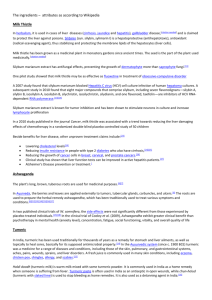
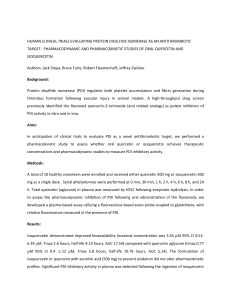
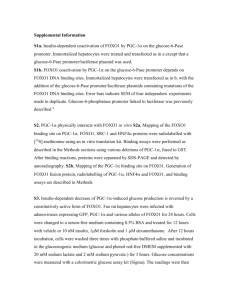
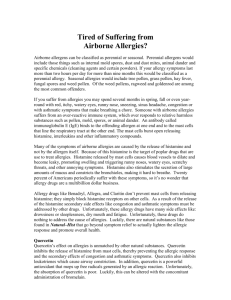
![Exploring Local Molecular Docking through YASARA[1] Andrew](http://s3.studylib.net/store/data/007513281_1-e667d2504f160fd3d45aa0d6a77022d2-300x300.png)
